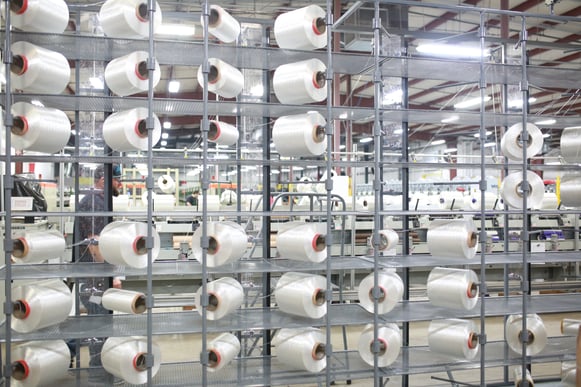
Tough and durable, UHMWPE (ultra-high-molecular-weight polyethylene) yarns have the highest tensile strength of any thermoplastic. You may also know these yarns by the names Spectra® and Dyneema®.
UHMWPE yarns are an excellent choice for high-tension, high-moisture, and high-abrasion applications. UHMWPE has a wide variety of uses from medical to manufacturing, including:
- Sports gear made for skydiving, skiing, and fishing
- Ballistics gear, like body armor
- Marine industry ropes, cords, and textiles
- Automotive industry equipment and parts
- Food and beverage industry processing
- Manufacturing and bulk handling equipment
- Industries like mining, minerals, civil engineering and earth moving
- Many types of ropes and cords
There are different grades of UHMWPE available, so it’s important to select the right manufacturer and type for your application. As an example, one of the grades Honeywell offers is a Spectra® type S-900 that has a modulus of approximately 900 g/den with an elongation at break of approximately 3.6%. This happens to be much different than one of DSM’s offerings, Dyneema® type SK-38, which has a modulus of approximately 396 g/den with an elongation at break of approximately 6.5%. Several company's offer a number of different grades and sizes that have various property differences.
Here are some of the key properties of UHMWPE to look at when choosing the material for your application.
Heat Resistance
UHMWPE has a lower heat resistance than many other types of high-strength fibers and a lower melting point (297° to 305° F) than many common polymers. All grades will have the same heat resistance and melting point because of the nature of UHMWPE.
As an example, UHMWPE is a good option for ballistic body armor used in security and police work, but is not a good choice for the manufacture of firefighters’ gear. But all grades of UHMWPE would have similar heat resistance level.
Tensile Strength
UHMWPE yarns are 40% stronger than aramid yarns. They also have high abrasion resistance, even under pressure, and are 15 times more resistant to abrasion than carbon steel. If strength and preventing breakage is of critical importance, evaluate your yarn selection to make sure it meets your tensile strength requirements.
UHMWPE is known for its high tensile strength - but always check product specs for exact tensile properties. Strengths vary depending on the grade, and exactly how each grade is drawn out. A skydiver doesn’t want their gear to break under high stress, and your company certainly wouldn’t want to be involved in the creation of any faulty materials that could cause an accident down the line.
Durability
Depending on the grade, UHMWPE usually has a molecular mass between 3.5 and 7.5 million amu, which is quite high. UHMWPE also has a very high cut resistance. It also has a very low coefficient of friction, comparable to polytetrafluoroethylene (PTFE), meaning it is well-suited for uses that involve motion and sliding. A common example is bulk handling equipment, which experiences constant repetitive motions.
It’s important to note that yarns can eventually develop what’s known as creep under constant tension loads. When creep occurs, this gradual elongation of fibers can create a more limited lifespan. Monitor this closely in conditions with unrelenting tension.
Creep is measured in modulus, or resistance to deformation. UHMWPE fibers have a high strength and a high modulus in the fiber direction. Because it also has a low density, it has a high strength on a weight basis.
UHMWPE has less creep than other fibers like polyester. If creep is of high concern - perhaps in the manufacture of recurve bowstrings - a UHMWPE grade with a higher modulus could be the best fit. UHMWPE also has significantly better UV resistance than aramid yarn and tends to be a better choice for outdoor applications.
As an example, there is a Dyneema® type SK 99 that has a modulus of 1801 g/den and also a type DM 20 that has a modulus of 1088 g/dn. Both of these materials are considered high modulus, however depending on which grade you choose, one could be significantly higher than another. Spectra® fiber has similar offerings with wide modulus ranges as well.
Chemical/Water Resistance
If the UHMWPE yarn will be exposed to chemicals and solvents, it’s good to know that it has strong chemical resistance - and that includes all UHMWPE, regardless of grade. It’s typically highly resistant to most alkalis, acids, organic solvents, degreasing agents, and electrolytic attacks.
UHMWPE has a low specific gravity, meaning it floats in water. It also has a high water resistance, making it good for use in the manufacture of aquatic gear and for equipment that will constantly be exposed to wet environmental conditions.
For example, ships' hawsers and cables are commonly constructed of UHMWPE due to the dual benefits of high resistance to water and high resistance to the abrasive action of sea salt.
Nontoxic and Safe
When made properly, all grades of UHMWPE are odorless, tasteless, and nontoxic. This provides safety for production workers in manufacturing operations, plus safety down the line for end users of products made with UHMWPE.
It’s an excellent choice for medical uses. UHMWPE has famously been used in total hip joint replacements for more than four decades because it provides a near-frictionless joint socket surface.
Which Type is Best For You?
With all of the variables, types and sizes, it can be difficult to choose the right UHMWPE to meet specific requirements. UHMWPE is a slick, expensive fiber that is extremely hard to process, so it’s important to select a reliable company to process this specialty fiber into finished product.
Service Thread processes UHMWPE yarns for a wide variety of applications. Contact the experts at Service Thread now to learn more about which type of UHMWPE is best for your application.



